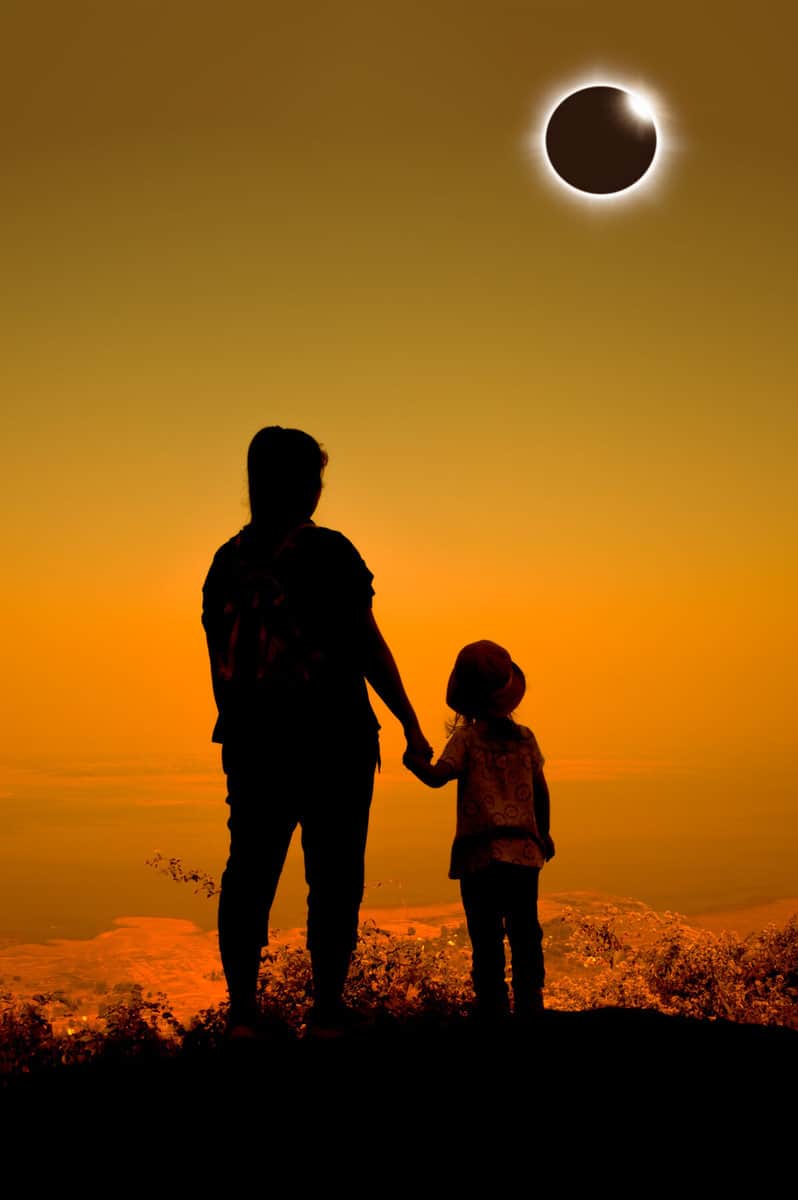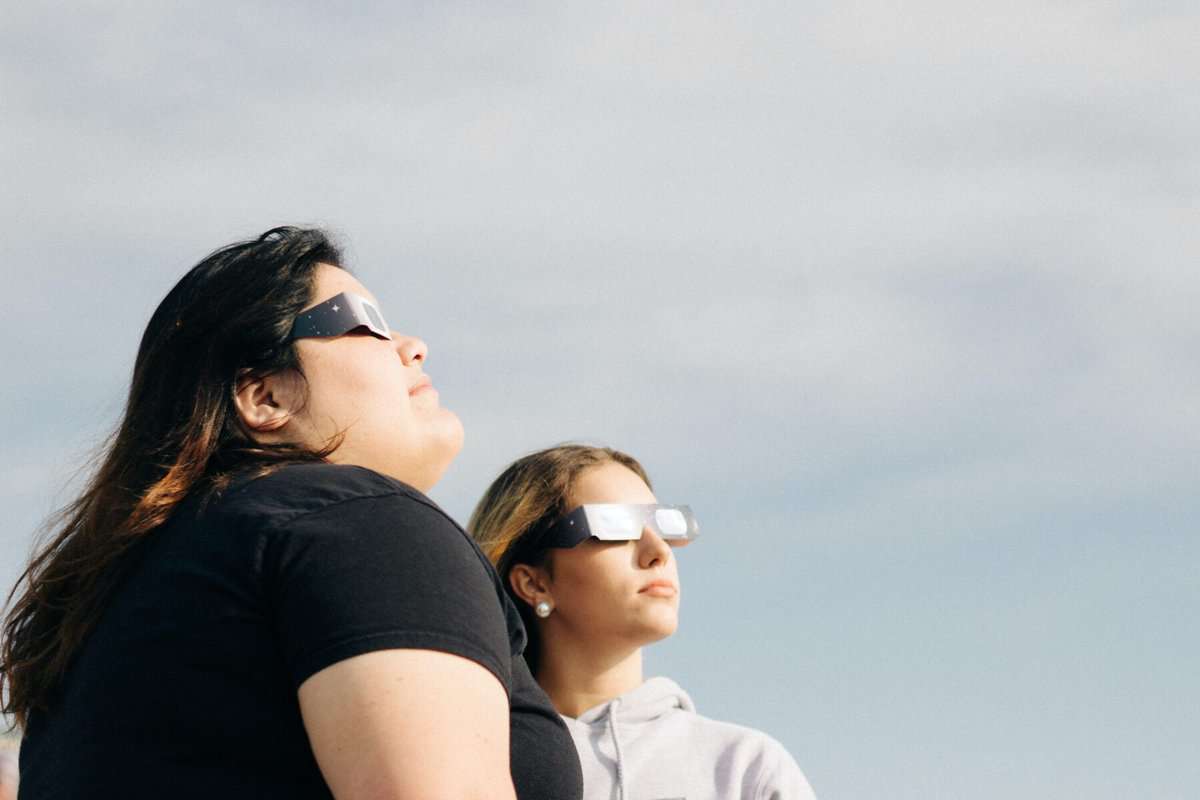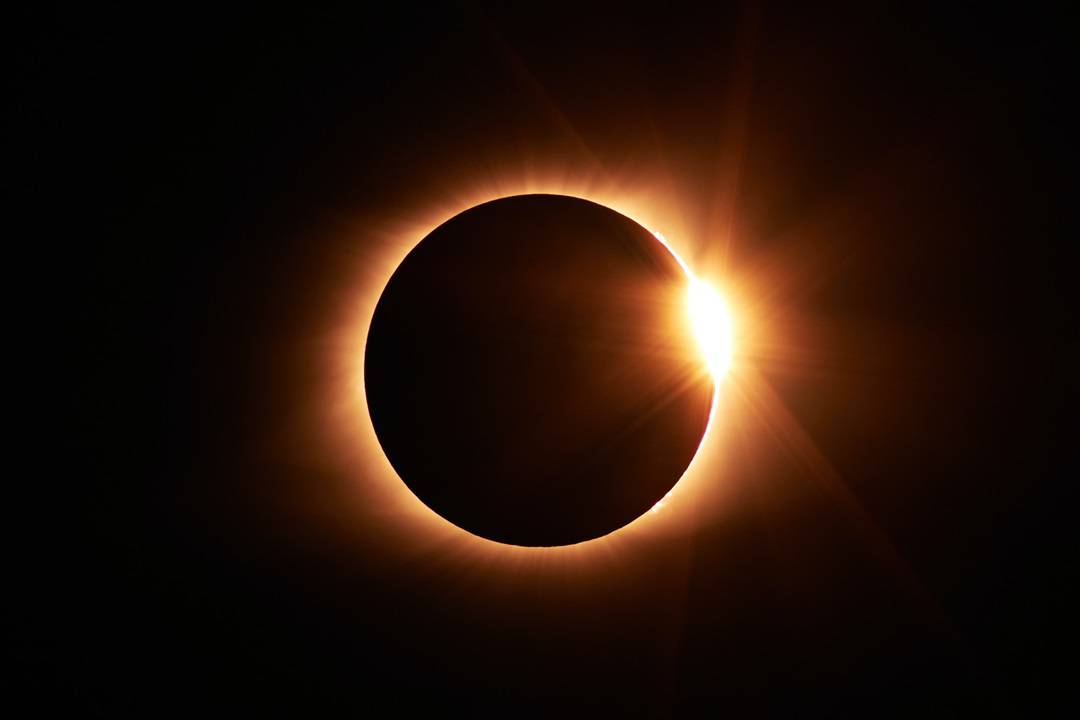I have a complicated relationship with astronomical events. Like many outdoor adventurers, I’m thrilled by the idea of space exploration. When camping out under the stars, we’re always looking up, wondering what’s out there. Spotting constellations, craters on the Moon, or the patchy band of the Milky Way. I also love museums with real-life spacecraft that have taken people into orbit and beyond. And visiting towering rockets, coastal launch sites, and mountaintop observatories where you can view sunspots or the rings of Saturn.
But the thing is, I don’t plan most trips with my wife or friends around museums, meteor showers, or eclipses. We plan trips around activities like paddling, hiking, and biking. If a space site happens to be within striking distance, we’ll happily detour. If a campsite falls within a dark sky area, all the better.
One night, we were driving across the desert in Utah when a bright streak came down from the sky, led by a glowing green orb that flashed and extinguished. We’d seen our first fireball meteor. Another cold night, in the San Rafael Swell, we watched from around a campfire as a long string of lights unfurled in orbit. This was during May 2019, and we later learned it was the first deployment of 60 test satellites for the SpaceX Starlink internet service.
But every now and then, an astronomical event comes along that’s worth going the extra mile. On April 8, a total eclipse will cross the continental U.S. from southwest Texas to northern Maine. Along the way, it will pass over the heart of the Ozarks. Many public viewing events at museums have long been sold out. But if you’re willing to venture further, there’s no reason you can’t have your own adventurous eclipse viewing.

After April 2024, the mainland U.S. won’t see another total eclipse for 21 years.
How an Eclipse Happens
During a solar eclipse, the Moon passes between the Earth and the Sun. With a partial eclipse, a sliver or more of the blinding solar surface will remain visible. With a total eclipse, the Moon blots out all but the corona, which is the glowing solar atmosphere. During an annular eclipse, the Moon is slightly closer to Earth, so it can’t cover the entire solar surface and we see a glowing ring.
Across the world, partial eclipses happen about twice a year and a total eclipse happens every 18 months, give or take. But we live on a big planet, with a diameter of 7,900 miles, so an eclipse might be visible from the same place only a few times per century. By chance, the Lower 48 has seen two eclipses in the past decade. During late August 2017, a total solar eclipse streaked across the country from Oregon to South Carolina, passing over St. Louis in the process. Then, in mid-October 2023, an annular eclipse — aka “ring of fire” — crossed the western U.S. from southern Oregon to southern Texas.
Due to some lucky celestial mechanics, the next one is happening in April.
To understand the different types of eclipses, it helps to discuss a few details about the Earth, Moon, and Sun. The Moon has a diameter of about 2,160 miles, which is like driving across Kansas about five times. That’s roughly 400 times smaller than the Sun, which has a massive diameter around 865,000 miles — just imagine driving back and forth across Kansas TWO THOUSAND times.
By chance, the Moon is also about 400 times closer to the Earth, or about 239,000 miles away, compared to the Sun, which is about 93 million miles away. Due to these relative distances, the apparent size of the Moon in our sky is about the same as the apparent size of the Sun. The Moon follows an elliptical path, meaning it can be slightly further from or closer to the Earth during its orbit. This allows for the variety of eclipses we can see from the ground.
Here’s another fun fact: The prevailing theory is that the Moon formed billions of years ago when a Mars-sized object impacted the primordial Earth. Molten debris was blasted into orbit and coalesced into our solid Moon. But it was originally much closer to Earth. Over time, the Moon has drifted away from our planet a few inches per year. As a result, millions of years ago, not even the solar corona was visible during a total eclipse. And millions of years from now, as the Moon appears smaller and smaller in the sky, all eclipses will become partial or annular. Thus, if you’re curious about a total eclipse, don’t wait around for millions of years.

The path of totality in the Ozarks in April 2024.
Worth noting is that the Moon projects a circular shadow onto the Earth’s surface that is only 100 miles wide. This is called the “path of totality,” and within this narrow corridor is where you want to be if your goal is watching the total eclipse. Outside that path of darkness, you can still see a partial eclipse of decreasing percentages the further away you are.
After the April 8 total eclipse, the mainland U.S. won’t see another one for 21 years, when a total solar eclipse will cross from northern California to south Florida in 2045. Put it all together, and the writing is on the map. Go watch the total eclipse now.
What You Need for Your Eclipse Adventure
Back in 2017, I wasn’t ready for the eclipse. I was rushing to launch a weeklong solo whitewater trip on Desolation Canyon in Utah. I knew that a partial eclipse would fall on the same day I started down the Green River. But with all the planning, packing, and driving in the weeks and days before, I forgot to order eclipse glasses. I figured I could pick them up during the long drive to the put-in. Instead, every store along the way was sold out.
So, by the time I hiked up from the silty river to a small mesa in a wide-open bend in the canyon, my eclipse kit consisted of a single beer in a brown bottle. Warning! Not only do I typically avoid glass on a paddling trip, but using a bottle is NOT a safe way to watch an eclipse. Regular sunglasses and glass bottles do not block dangerous infrared and x-ray radiation that can permanently damage your eyes.
Still, I set up my camping chair, drank the beer, and briefly glanced through the brown glass into the darkening sky. Here’s the thing, I could kind of see it. But the image was so blurry and intense, it just wasn’t worth trying. Instead, I mostly watched the changing light and shadows across the high desert scenery and canyon walls. The trip went perfectly, and I didn’t worry too much since I knew there would be further chances to see an eclipse.
To safely watch an eclipse, you need an ultra-dark viewing device that complies with the international safety standard called ISO 12312-2. The simplest and cheapest options are eclipse glasses, which resemble cardboard or plastic 3D glasses from movie theaters. Another option is a handheld eclipse viewer, which has a larger filter screen that you hold in front of your face. There are certainly other devices out there, but if your goal is to have an adventure with a slice of eclipse, either of these methods should work fine.

Use ISO 12312-2 glasses to safely view the eclipse.
When is the Eclipse and How Can I Get More Info?
The eclipse happens on Monday, April 8. The exact timing depends on where you will be that day. In the Midwest, the Moon will begin a partial eclipse at roughly 12:30 p.m. CDT. Total darkness will occur around 1:55 p.m. and last only two to four minutes, depending on your location. Then a partial eclipse will resume as the Moon passes away from the Sun. The eclipse will be over by about 3:15 p.m.
NASA has created a webpage with a downloadable map showing the path of totality, plus a table showing estimated times by location at science.nasa.gov/eclipses/future-eclipses/eclipse-2024/where-when/.
Where to Watch the April Eclipse
Thirteen states fall within the path of totality. But some regions tend to have a higher chance for cloudy or rainy skies during the typically wet month of April. Much of northern Ohio and southern Indiana are in the path, but know that these states have a 75-percent chance, give or take, for some cloud cover. Heading south from there yields increasingly better odds of clear skies, including southern Illinois and southeastern Missouri hovering closer to 60 percent. Many eclipse enthusiasts are heading down to southwestern and central Texas, where April weather offers the highest chance for optimal viewing conditions with 50-50 odds. But the second-best area to consider is Arkansas, where the odds are just north of even for clear weather and where the path of totality makes a big sweep from the Ouachita Mountains to the Ozarks.
One way to experience the eclipse is at watch parties, many of which are hosted in public parks or fairgrounds (see sidebar). Large parking lots are another popular place to go. In a way, along the zone of totality, the 2024 eclipse weekend will be similar to summer holidays like Memorial Day or Labor Day. So, if you have a go-to game plan for such weekends, it might be the ticket on eclipse day.
Ways to Experience the 2024 Eclipse
In Ohio, Cuyahoga Valley National Park is preparing for overflowing parking lots and roadways. In Indiana’s Little Smokies, Brown County State Park will be a destination. In Shawnee National Forest of southern Illinois, Garden of the Gods will definitely get trampled. In the Missouri Ozarks, Elephant Rocks State Park will be a popular choice. And near Little Rock, Arkansas, Pinnacle Mountain will be busy.
Yet even within these popular parks and regions, there will be ways to beat the crowds by venturing further. At Cuyahoga Valley, you could park on the periphery of the park and bike the gravel Towpath Trail until finding a suitable open space. At Brown County, you could avoid the parking and camping rush by biking into the forested park and then riding the road or singletrack trails until you find a suitable clearing.

Beat the crowds with an eclipse bike ride. (Mike Bezemek)
In southern Illinois, there are other great trails and rec areas beyond Garden of the Gods. For example, the Cache River State Natural Area spreads over 14,000 acres, with a mix of open fields and waterways. The visitor center parking lot will likely fill up, but you could always walk or bike into the preserve on the Tunnel Hill State Trail, with several trailheads falling within a few miles.
In the Missouri Ozarks, Elephant Rocks and nearby Johnson Shut-Ins will likely be crowded. But you could break out boats on some of the region’s waterways. The Current River would be a good choice. Between Baptist Camp and Round Spring, there are six canoe launches. Give yourself enough time to paddle down until you find a nice gravel bar, beach, or accessible bluff with a clear view of the sky. Other Missouri Ozark rivers that fall within the zone of totality include the Jacks Fork and the Eleven Point, with the latter being particularly suited for an overnight trip.
If you prefer to hike to your viewing site, the Irish Wilderness is on the eastern bank of the Eleven Point. The mileage from the main trailhead to the open bluffs by the river will run you about 8 to 10 miles, so backpacking would probably be preferred. Or look elsewhere for hiking options. A section of the Ozark Trail runs through the heart of Ozark National Scenic Riverways. Or nearby, there’s a scrambling area with open views at Rocky Falls.
Down in Arkansas, there are numerous options to consider. The Spring River, Big Piney Creek, and the Buffalo National River all fall within the zone of totality. Regarding the Buffalo, the area around Steel Creek will likely be jammed. But plenty of quieter spots could be found by paddling sections of the middle or lower river. Meanwhile, the 36-mile Buffalo River Trail roughly parallels the upper river and has seven trailheads allowing shorter or longer hikes.
My plan is to stay flexible. I’ll keep an eye on the prevailing weather patterns as spring develops and then head to the Ozarks of southern Missouri or northern Arkansas for some eclipse adventuring. While I haven’t decided yet, I’ll either be hiking, biking, or paddling to my watch area. If the rivers are up and trails are soggy, I’ll go by boat. If dry conditions are in effect, my boots or bike are the ticket to totality.
Of course, this activity-first approach can have its limits when it comes to viewing astronomical events. Some river camps might be perched against a cliff, blocking half the sky. Definitely give yourself enough time to find a suitable spot. Or the weather might not cooperate, with cloudy or overcast skies obscuring the show. That’s what happened to me during the October 2023 eclipse. I was biking the Tunnel Hill State Trail that day, with my eclipse glasses tucked into my cycling pack. The view of the sky was wide open, but the overcast clouds never broke. Since I had a great day on the bike, the trip was still a success.
So, if having an eclipse adventure sounds like fun, just start looking at the map. Pick a lesser-known trail or river section you’d want to check out anyway. Maybe something in a national forest, national park unit, or state park. Maybe a place with a non-reservable campground or backcountry camping. If you can arrive before the Friday of eclipse weekend, and stay through Monday, even better. That said, a day trip might also work with an early start. When the time comes, go have an adventure. And don’t forget to look up.
Party in the Path
One way to experience the eclipse on April 8 is at watch parties, many of which are hosted in public parks or at fairgrounds. Here’s a sampling of Missouri events that will take place in the path of totality.
April 4-8
Total Solar Eclipse Festival
West Plains, Mo.
explorewestplains.com/tse/
April 5-8
Solar Eclipse Festival
Benton, Mo.
bentonspeedway.com/eclipse-festival
April 5-8
Solar Strings Eclipse Festival
French Village, Mo.
astralvalley.com
April 5-9
Eclipse Escape
Lesterville, Mo.
one.bidpal.net/eclipse
April 5-9
Missouri Eclipse Festival
Blackwell, Mo.
missourieclipsefestival.com
April 7-8
Blinded by the Light in Arcadia Valley
Ironton, Mo.
visitmo.com
April 8
Eclipse Ride 2024
O’Fallon, Ill.
bikesurgeon.com/product/eclipse-ride-2024
April 8
Total Eclipse of the Park
Sikeston, Mo.
sikeston.net/tourism
Find even more events in Missouri and beyond at nationaleclipse.com/events.html.
Author: Mike Bezemek is a contributor to Terrain Magazine.


[…] On April 8, a total eclipse will cross the continental U.S. from southwest Texas to northern Maine. Along the way, it will pass over the heart of the Ozarks. Many public viewing events at museums have long been sold out. But if you’re willing to venture further, there’s no reason you can’t have your own adventurous eclipse viewing. Learn more from Terrain Magazine! […]
One of my favorite eclipse articles I’ve read. Thanks for your sensible, fun perspective.